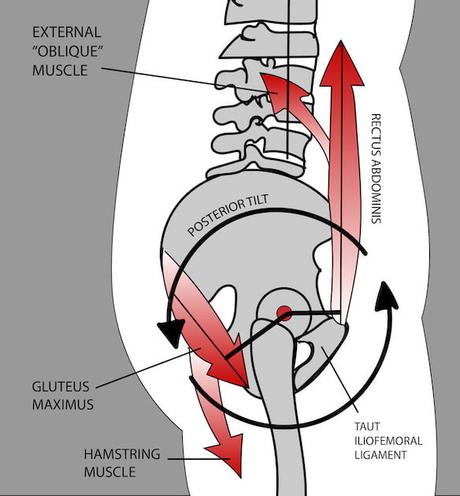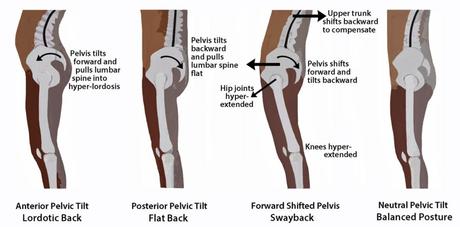Its types and treatment
Back pain can be caused by various reasons such as accidents, falls, or arthritis. In many cases, improper body position can be the cause of back pain. In such a situation, we will witness back pain and degrees of hip rotation.
Pelvic Rotation and Back Pain
The pelvis is a bone that connects to the spine as well as the thighs. The pelvis can rotate forward and backward, bend, or extend up and down. Such pelvic movements may not be felt, but they can cause problems in nearby areas. The back of the body and the waist are among these areas.
Hip Rotation Forward and Backward
When the pelvis rotates forward or backward, it only moves in one direction, and each rotation can have different effects on the back and waist. Posterior and anterior rotation of the pelvis can lead to pain.

Forward Hip Rotation
Anterior rotation of the pelvis can stretch the back muscles because it creates some curvature in the healthy spine. Positional problems associated with anterior rotation of the pelvis are more common than problems with posterior rotation of the pelvis.
Severe excess weight in the abdominal area, such as during pregnancy, is one of the causes of anterior rotation of the pelvis.
Correction and Treatment of Pelvic Rotation
In most cases, severe postural problems resulting from anterior and posterior rotation of the pelvis are well corrected with exercise programs designed to target the resulting deviation.
Pelvic Tilt
Pelvic rotation or one side of the pelvis being up is known as pelvic tilt and the symmetry of the pelvis is disrupted.
In most cases, when one side of the pelvis is higher than the other, we will also see a difference in the length of the legs.
Different leg lengths can be functional or anatomical.
Most people whose legs are not the same length are involved in the functional type, which means that this condition is caused by the way the body is positioned and the imbalance and balance of the muscles.
Overall, functionally different leg lengths can lead to pelvic tilt.
People with these conditions will be subject to scoliosis or spinal curvature. In such a situation, first, we will see the pelvis tilting and eventually the spine will be uneven and this area will be curved.
Different leg lengths can make it difficult for a person to perform daily activities such as sitting, standing, walking or doing housework.
Different Lengths of Legs in Terms of Anatomy
In such cases, one leg is longer than the other and the hip bones are aligned horizontally.
This condition is associated with severe pain and can overshadow daily and social activities.
In general, this situation is corrected by placing a special pad inside the shoe of one foot that is shorter than the other.
A strength program can also help relieve pain and increase strength, as it targets pelvic muscle imbalances.
The point that we should mention is that in the case of all the problems related to the body position, an orthopedic specialist should be consulted. Because this is considered a medical condition.
How to Diagnose Pelvic Rotation Syndrome
Usually, when a person goes to the doctor because of pain in the pelvic area, it is examined and evaluated. Then the doctor will prescribe the Thomas test for the final diagnosis.
For this test, the patient should lie on the bed in such a way that his legs hang from the bed. After that, he should keep his leg up and bend it a little.
At this time, if the person’s pelvis does not have correct symmetry, the person’s leg will be removed from the bed. This is indicative of hip rotation syndrome.
Therefore, the doctor should use pelvic rotation therapy for the patient.

Complications of Not Treating Pelvic Rotation
Note that if you do not pay attention to the pelvic rotation syndrome and do not do this treatment on time, you will suffer more complications.
Because this problem affects other parts of the body and causes pain in those areas.
Among the complications of not treating hip rotation, we can mention shoulder pain, neck pain, back pain, as well as knee and joint pain.
What is Podiatry? Anterior Cruciate Ligament InjuriesHow to Treat Pelvic Rotation
In general, people who suffer from forward pelvic rotation syndrome face stretching of the back muscles. As a result, their spine will be curved.
This issue can be caused by factors such as sitting for a long time, improper position while doing work, stiffness of the quadriceps muscles, etc.
On the other hand, if the pelvic rotation syndrome is backward, it causes the pelvic area to deviate downwards.
Among the reasons that cause this rotation are weak back muscles, hunchback, stiffness of gluteal muscles, etc. cited.
Note that the main sign of the backward rotation of the pelvis will be the curvature of the spine.
It is better to know that when people suffer from such a problem, like treating hip pain with physiotherapy, they must see an orthopedic specialist.
At this time, the specialist doctor prescribes various methods for the treatment of pelvic rotation, which include proper exercise, massage therapy, and electrotherapy using a physical therapy device.
Each of these methods is briefly explained below:
Performing Appropriate Exercises
One of the ways to treat hip rotation is to do proper exercises.
Because sports exercises strengthen the muscles inside the patient’s thigh. Also, these exercises help to increase the patient’s flexibility and range of motion.
Of course, note that you must use stretching movements for this treatment. This may cause pressure in the knee area.
Therefore, if you are facing the problem of knee pain, it is better to avoid therapeutic exercises.
But when a doctor who specializes in this field suggests doing exercise for treatment, it is better to follow his opinion. Usually, the exercises that are used to treat hip rotation can include the bridge movement with the gluteal muscles, the plank movement, the squat movement, etc.
Of course, when doctors suggest doing sports exercises to treat hip rotation, they also remind a few important points.
These points can be expressed as follows:
- Do the exercises very slowly and try to strengthen your muscles over time.
- Exercises should be done in such a way that the person does not feel pain or even increase in pain.
- You may feel bruised in your muscles after a hard workout, which is completely normal. But if you experience sudden pain in the joints or muscles, you should contact a doctor.

Physiotherapy
When the doctor prescribes physiotherapy for you, you should see a skilled physiotherapist.
At this time, the physiotherapist performs the treatment of pelvic rotation in two stages, one stage includes electrotherapy, which is performed with the help of a physiotherapy device, and the next stage is stretching and strengthening exercises.
In general, these factors ultimately create symmetry and balance in the patient’s pelvic region.
Physiotherapy is performed in several treatment sessions, the number of treatment sessions will be determined according to the opinion of the specialist doctor and physiotherapist.
Massage Therapy
One of the other ways to treat pelvic rotation is massage therapy. Doing massage therapy can bring many benefits.
Among these benefits, we can mention pain relief, reducing inflammation, as well as improving blood circulation and relaxing muscles.

